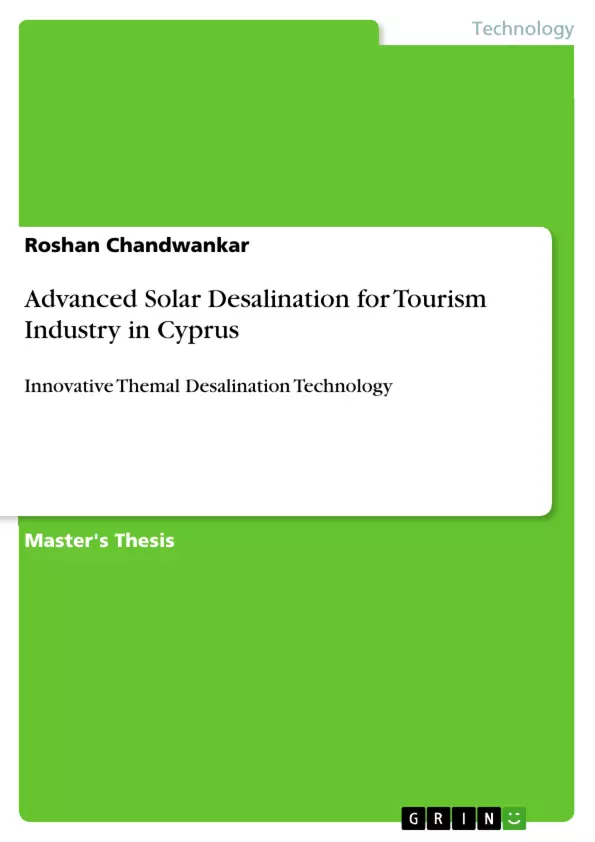Despite the fact that global water is apparently abundant, almost half of the world faces the water scarcity especially in the Mediterranean and North African regions. The main purpose of this work is the assessment of Multiple Effect Distillation, a thermal desalination technique in water stressed countries in the Mediterranean region.
The thesis describes a case study for desalination plant solution of capacity 900 m3/d for a hotel location in Cyprus. The study features plant design and the performance data ensuring low specific electrical and thermal energy consumption. A detailed mathematical model is developed for the 8 - effect desalination plant which is based on the mass and energy balances for the streams flowing through each stage of the MED unit. The performance of the desalination can be predicted. An improved model for the desalination technology can be suggested by installing an additional unit called as thermo – vapour compressor. The Gained Output Ratio (GOR) and specific thermal energy consumption values of 13.6 and 40.1 kWhth/m3 respectively are obtained from the improved model.
The plant can be operated throughput the year by implementing an innovative technique of sea water preheating. This helps in achieving the required brine feed temperature of about 43 – 48 °C. The improved plant model is assessed by a simulation software, DEEP. The Mediterranean region has huge potential in renewable energy especially in solar thermal energy. A medium temperature parabolic trough collector operat-ing at 180 °C will be used to supply the steam for desalination plant. With the fossil fuels powering most of the desalination plants, the use of solar thermal energy can be a clean and sustainable option and an ideal benchmark for the future renewable desalination plants.
Inhaltsverzeichnis (Table of Contents)
- Introduction
- Advanced Solar Desalination for Tourism Industry in Cyprus
- 1 - Water Consumption in the Tourism Industry
- 2 - Market Analysis of Cyprus
- 2.1 Economy of Cyprus
- 2.1.1 Tourism Industry in Cyprus
- 2.1.2 Tourist Occupancy in Cypriot Hotels
- 2.2 Need for Desalination in Cyprus
- 2.1 Economy of Cyprus
- 3 - Desalination
- 3.1 Classification of Desalination Technologies
- 3.1.1 Membrane Desalination
- 3.1.2 Thermal Desalination
- 3.2 Comparison of Performance of Desalination Technologies
- 3.2.1 Advantages of MED Desalination Process
- 3.2.2 Limitations
- 3.3 Existing Desalination Plants in Cyprus
- 3.4 Case Study: MED Desalination Technology
- 3.4.1 Existing Facilities
- 3.1 Classification of Desalination Technologies
- 4 - MED Desalination
- 4.1 Evaporator
- 4.2 Demister
- 4.3 Condenser and Flash Distiller
- 4.4 Brine Feed Configuration
- 4.4.1 Forward Brine Feed Configuration
- 4.4.2 Backward Brine Feed Configuration
- 4.4.3 Parallel Brine Feed Configuration
- 4.5 Selection of Desalination Plant Capacity
- 4.5.1 Calculation of Desalination Capacity
- 4.6 Sensitivity Analysis of the Plant Capacity
Zielsetzung und Themenschwerpunkte (Objectives and Key Themes)
This master thesis provides a feasibility analysis of a Multiple Effect Distillation (MED) desalination plant for a hotel location in Cyprus. The main focus is on assessing the performance and energy consumption of the plant, exploring the potential of solar thermal energy as a sustainable alternative to fossil fuels. The study incorporates plant design, detailed mathematical modeling, and simulation using the software DEEP. The thesis also aims to contribute to the understanding of sustainable water management strategies for the tourism industry in Cyprus. Key themes covered in the thesis include:- Water scarcity in the Mediterranean region and its impact on the tourism industry
- Feasibility analysis of MED desalination technology for tourism facilities in Cyprus
- Optimization of plant design and performance parameters to minimize energy consumption
- Integration of renewable energy sources, particularly solar thermal energy, in desalination processes
- Sustainable water management strategies for the tourism sector in Cyprus
Zusammenfassung der Kapitel (Chapter Summaries)
The thesis begins by examining the water consumption patterns within the tourism industry, highlighting the specific challenges faced by Cyprus due to its arid climate. The market analysis focuses on the Cypriot economy and its reliance on tourism. The subsequent chapter delves into desalination technologies, comparing different methods and emphasizing the advantages and limitations of MED. This section also explores existing desalination plants in Cyprus, establishing the context for the case study presented later. Chapter 4 provides a comprehensive overview of MED desalination, including detailed descriptions of the key components like evaporators, demisters, and condensers. The chapter also explores different brine feed configurations and analyzes the sensitivity of the plant capacity to various parameters. The concluding sections of the thesis focus on the design and simulation of the MED desalination plant, exploring the use of solar thermal energy as a sustainable alternative to fossil fuels for powering the desalination process.Schlüsselwörter (Keywords)
The key focus of this research revolves around the application of desalination technology, particularly MED, for supplying water to the tourism industry in Cyprus. The research investigates the integration of renewable energy sources, specifically solar thermal energy, to create a sustainable solution for water management. The core concepts explored include plant design optimization, energy consumption analysis, and the impact of water scarcity on the tourism sector in Cyprus. Key terms that encapsulate the research focus include: tourism industry, Cyprus, MED desalination, solar thermal energy, energy efficiency, and sustainable water management.
- Quote paper
- Roshan Chandwankar (Author), 2016, Advanced Solar Desalination for Tourism Industry in Cyprus, Munich, GRIN Verlag, https://www.grin.com/document/354919



